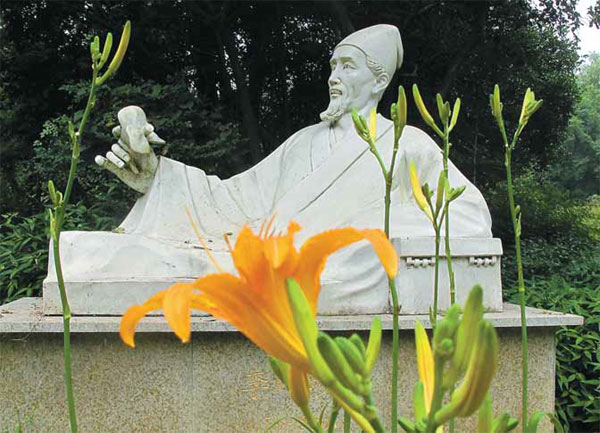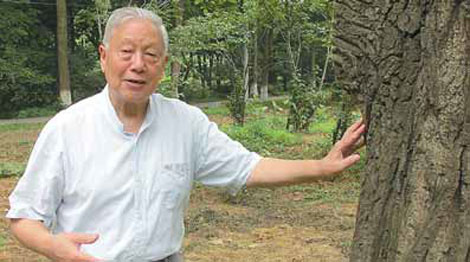Cultivating interest
Updated: 2014-07-06 07:04
By Mike Peters(China Daily)
|
|||||||||
|
A statue in the Nanjing Botanical Garden honors the famous herbalist Li Shizhen (1518-1593). The great doctor wrote a famous textbook, A Compendium of Material Medica. Mike Peters / China Daily |
The life of He Shan'an shows sometimes being a botanist means shooting trees with a gun. Mike Peters speaks with the 'godfather of China's botanical gardens'.
In 1980, five US plant scientists came to China for both herbarium study and "botanizing" fieldwork. Two years later, five Chinese experts went to the United States in a reciprocal visit. It was the first such exchange since World War II. "It was most thrilling for the Chinese scientists, who had previously had no opportunity to go to a Western country for such research," says professor He Shan'an, who helped to host the Americans and was later part of the traveling Chinese research team.
"But it was also very important for the US scientists, whose China collections were old - and based on a selection of plants that was very small."
He, now retired as the director of the Nanjing Botanical Garden, has lived his life among passionate botanists but likes to joke that he's no such thing.
"As a boy I was fascinated by foods from Western countries. The Sunkist orange! Amazing!" he says, chuckling.
His father would cut a grapefruit in half and put sugar on two sections, but not before young He had a good look.
"Morning meant milk and Quaker Oats," He says.
"Actually, I'm not a plant guy. I'm an eater! From middle school until I was going into university, I had no idea what I wanted to do."
He came from a large family and his six siblings became engineers, a literature specialist and a chemist. One brother went to the military.
"My father wanted diversity in the family," He says.

"So when my time came to go to university, he said: 'What about agriculture - good for you?'"
It has been very good for He, who's revered by peers at home and abroad as a godfather of botanical gardens in China. His CV lists dozens of important publications, positions and committees, as well as research in fields from citrus to olives to medicinal and endangered plants.
He smiles when asked if plant-collecting in the wild is an exciting adventure, waving away notions of Indiana Jones-like characters hacking their way through remote jungles. But the 1980 trek for the visiting US scientists had some unexpected drama.
"There was a big worry about the safety of our foreign guests - it wasn't clear who was responsible for that," He says, with a big smile.
"So the authorities did something unprecedented: They gave us two guns to take with us!"
That was mostly for protection from animals, not bandits or other criminals, He says.
But he chuckles at the memory of another factor: reports that a Bigfoot-type creature was roaming the forested hills of Shennong-jia in northwestern Hubei province, where the scientific team was heading.
"The joke at the time was that 'Bigfoot' had one foot in California and one in Shennongjia," says He of the fabled bearlike monster.
While the group never saw such a monster, the guns had some practical value.
"One of the species we were most interested in was the metasequoia, a giant evergreen tree," He says.
Chinese redwood or dawn redwood (Metasequoia glyptostroboides) was described as extinct and only found in fossilized form as late as 1941. But in 1944, professor Zhan Wang collected the species in Hubei province, climbing to the top of a temple roof to retrieve a fruiting branch.
Flash forward to 1982, when the US and Chinese scientists were roaming forests where the trees, up to 61 meters high, were far from any convenient temple roofs. Branches with new growth, not to mention the reproductive parts and seeds, were near the treetops.
The scientists looked heavenward in frustration - until somebody remembered the guns.
"Shooting the branches out of the trees was very efficient once we got the nerve to do it," He chuckles.
Today the retired professor often travels from Nanjing for consultations about plants that may offer new value as medicines, cosmetics and food.
The Italian cosmetics firm Indena, for example, is experimenting with ancient Chinese flora (ginko) and a hot new crop in the country (blueberries) for cosmetic and health-supplement products. Extracting the flavenoids of Ginko biloba is an extension of traditional Chinese medicine into the modern pharmacopeia, while aklaloid derivatives of the "happy tree" (Camptotheca acuminata) offer something modern - a potential cancer cure.
"There is so much promise in plants," He says.
"We must make sure that botanical gardens and the work done there are a benefit to human beings forever."
|
Professor He Shan'an examines apple trees on a recent visit to the Xinjiang Uygur autonomous region, where he hopes one day to see a new botanical garden that can document the plants of western China. Provided to China Daily |
(China Daily 07/06/2014 page3)

